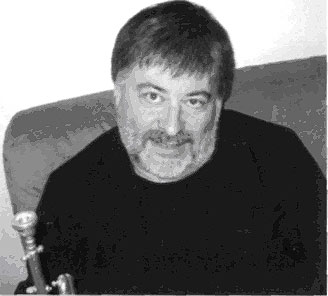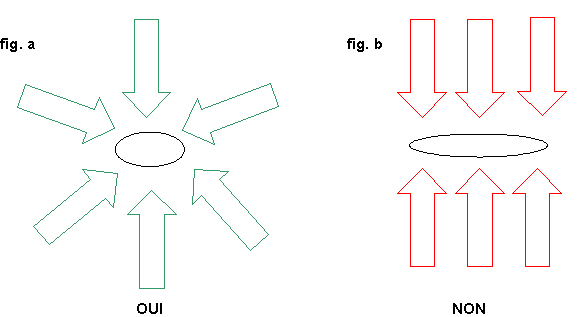| Introduction | Breathing | Posture | Emission of sound | Lips | Pedagogy |

This article is principally of interest to those who play an instrument with a mouthpiece. They use two membranes which are an integral part of our body--lips. However, other wind instrumentalists, using their mouth to play, may also read this page and understand that any tense and voluntary action of that part of the body will lead to the same results I am about to explain.
The work of the lips takes too predominant a role in the way some musicians play. They limit themselves to finding different ways to position their lips, trying to modulate the pinch as the range of sound change. This concern often overshadows the main process of sound production based on the technique of "relaxed breathing" and which has been discussed in previous pages. Those different positions cause the facial muscles to contract, which is detrimental to relaxed playing. The mouthpiece more or less squashes the lips. This is sometimes called "playing on the mouth". It leads very rapidly to physical tiredness and being less in tune, (the tone rises) and a difference in the quality of sound. It is always
possible to correct the problem, but how complicated that is and how it jeopardize your confidence!
Mr Robert Pichaureau went through all of this in his beginnings as a trumpet player. He was intelligent enough to ask himself why and to analyze the situation so he could share it with us. We will never be able to thank him enough. As in the previous pages, I try to put in writing for you, what he taught in his lessons and that I still feel today. I also refer to the Journal of Médecine des Arts N°8 (June 1994), quoted in my introduction. The physiological medical test carried out by a college of professors from Pitié Salpetrière Faculty in Paris revealed "no-pressure" of the mouthpiece on my lips. Indeed, in the same exercise of arpeggios, low - high -
low, the pressure exerted on the lips was 0.5 kg for me on the top notes and 3 kg for the other player. The "trauma" (medical term), on the two lips and the teeth, was not obviously identical. The consequences are much more weighty in the second case. Let us consider then which is the most favorable procedure to play for longer and without unneeded pain.
We may note that the noise of the sound coming from the instrument is the result of the amplification of vibrations caused by the two membranes--"lips". It is comparable to the noise made by a mosquito flying. But this vibration should not be obtained by muscular pressure of one lip on the other with intent to force them closed, but be a passing
of warm breath (as in singing) between the two firm membranes. To illustrate this, take a conversation for example: "Good day, perhaps you are going to Paris?" If you lean heavily on the consonants, insisting on the start of each word or phrase, you will probably obtain a broken up conversation, not very melodious to the ear: "Good Day, Perhaps you are Going To Paris?" It is concentrating of the start of the pronunciation that creates the problem. It is the player's "pou" on the mouthpiece which has replaced the famous "tu" of former generations, obtained by quickly pulling back the tongue from between the teeth as if to remove a fleck of tobacco stuck on them. This practice is luckily infrequent now, but nevertheless the "pou" is still
risky since it involves closing the lips first and opening them only by force under pressure. This technique contradicts everything I have explained in preceding pages.
Of course the position of the upper and lower lip must be taken into consideration, but only at the same level as when one whistles. Whistling while you work for example. Some people cannot whistle, either because they force the round shape of the lips or because it's too relaxed. One must find a compromise between the two. Very often, whilst looking for the sound, people tend to hold their breath by contraction. When there are problems pinching the mouthpiece, the lips should never be exercised independently of the body's other breathing movements.
We shall then analyze this external part of the body, which is the first to be in physical contact with the instrument. The first part of the instrument in contact with the body is of course called the mouthpiece.
On one hand we have living flesh, in two parts, composed of muscles irrigated by small blood vessels, all this resting on the teeth. On the other hand is just one element, a metallic mass, more often than not, an inert and hard circle. This initial comparison, based only on the simple description of the matter of these two elements, would lead us to believe that when they first meet
there would be "difficult and painful defeat of flesh on metal". Some trumpet players suffered during their careers (sprained lips, surgical operations etc.). Hence it becomes really important to find a lip position, placing them in a pinching hold which is the most effective, long lasting and comfortable possible. I would remind you that playing a musical instrument is an artistic fulfillment for human beings, where the result and the artistic value are not measured on the scale of physical suffering.
To achieve this, logically it is necessary to pull as many muscles together as possible into a concentric circle to take the metal circle of the mouthpiece. Louis Maggio illustrates this very well with a frontal photo of a chimpanzee. The two lips come together, the corners of the mouth tend to tighten up (fig. a). One may see the form of a volcano. What must be avoided, is the widening of the corners of the mouth to form a pinching hold that looks like a pair of pincers. (fig. b)

One can also copy the mouth position of a small animal calling, to quickly get the lips into place.
The action of the mouthpiece is limited to a simple reception of the vibrations. I name it "wash basin for vibration reception". Of course, the shape of the "wash basin" affects the making of sound. The depth
and width of the cup, its rim, the throat and the backbore, all affect the conduction of vibrations inside the attached pipe (trumpets, horns, trombone, tubas).
However, not to keep thinking of this "problem" of vibration {"please let me get a vibration at the right time"), the best method is precisely not to try and do it. That may appear contradictory and yet...! To understand this more clearly, let us come back to the production of sound with our voice. When we speak, our vocal cords operate without us specifically trying to make them vibrate. The passage of hot air held back is sufficient. The more we hold it back, the more melodious is the vibration (see previous pages).
Unfortunately, some jobs using the voice can lead us adrift before we notice and damage our vocal cords
making us lose our voice: the school teacher for instance. He, or she, voluntarily pulls on the throat muscles too much. He does not hold back his breath enough. We say that he has externalized and saturated the passage between the vocal cords.
Basing my argument on this comparison, I advise singing first a very deep "U" thereby setting the vocal cords into vibration just before the lips, by pulling them together as shown above. To begin with, keep the two sounds. You will notice that your mind is much less focused on the vibration of the lips. The desire to make them vibrate is less urgent. If you cannot make both sounds at the same time, this means that you are using too much air and not holding it back, (ref. work on the diaphragm). Secondly, you must try to change the range of sound of the
trumpet without moving the pitch of the singing. This is not easy at first, but you should try every day and gain little by little in the instrument range. You should not try to put colour into your singing, the vocal cords must work as slackly as possible. The best way is to imitate a groan, close to a low note relative to each person, without scraping the vocal cords. All through these exercises it is important to keep the lips together as shown in the drawing above. The internal bodily sensations should be engraved on our subconscious, so that they can be reproduced without using the vocal cords.
To understand lip vibration more clearly, it is interesting to compare the passage of hot air to a rubber ball. It will bounce back very quickly on a hard surface but will fall with no rebound on a soft surface. Hence the necessity of
having firm lips so that the warm breath may rebound and form a vibration. This is unfortunatley where the instinct to press the lips on the mouthpiece comes from. Indeed, pressing hardens and tenses the two membranes. It is absolutely out of the question if one wishes to play for a long time or obtain the very top notes easily and perfectly.
As you may realise, the part "mechanical pinching" must be exercised at the same time as working on the rest of the body.
To summarize, the mouthpiece should be set upon lips that are together, firm and not hermetically stuck, then you use the singing breath to create the vibration. From then on, the sensation of the mouthpiece on the lips should be mentally forgotten as much as possible and one should listen only to the sensations inside the body. In simple terms; interiorize.
It is not very easy to explain this method in writing, as the polysemy of words and difference in culture of each person may lead to differences in comprehension and interpretation. I already pointed this out in my first page. It was also the reason why Mr Robert Pichaureau never wanted to fix in writing what he experienced and explained, in order to avoid misleading and bad interpretations. He did not wish to enclose his ideas into "wise pre-requisites". He preferred the method to remain open, accesible to all those who wish to reflect simply and humbly on themselves. That is why I also insist on the importance of meeting people. I can explain my techniques orally with them (at a seminar or a day's training course), and of course during lessons in music schools where numerous parents of younger pupils are interested in this method, which moreover, they can apply to daily activities.
To continue logically and coherently, my next pages will be about instrumental pedagogy resulting from this approach based on "natural breathing", observing the body and the liberating of sensations to better the music. Mr Pichaureau said: "there is an artist sleeping in everyone, without exception. Its roots are in ones deepest being. Each person must strip themselves naked. It is through permanent research and having confidence in oneself daily, that the artist is revealed. And not in coercive measures, with their share of suffering, with a dominating and "go-getter" state of mind. Questioning oneself assures the evolution of mankind."
This humanist thought is, I deeply believe, the basis for pedagogy with profound respect for mankind.
© Alain Faucher 2006